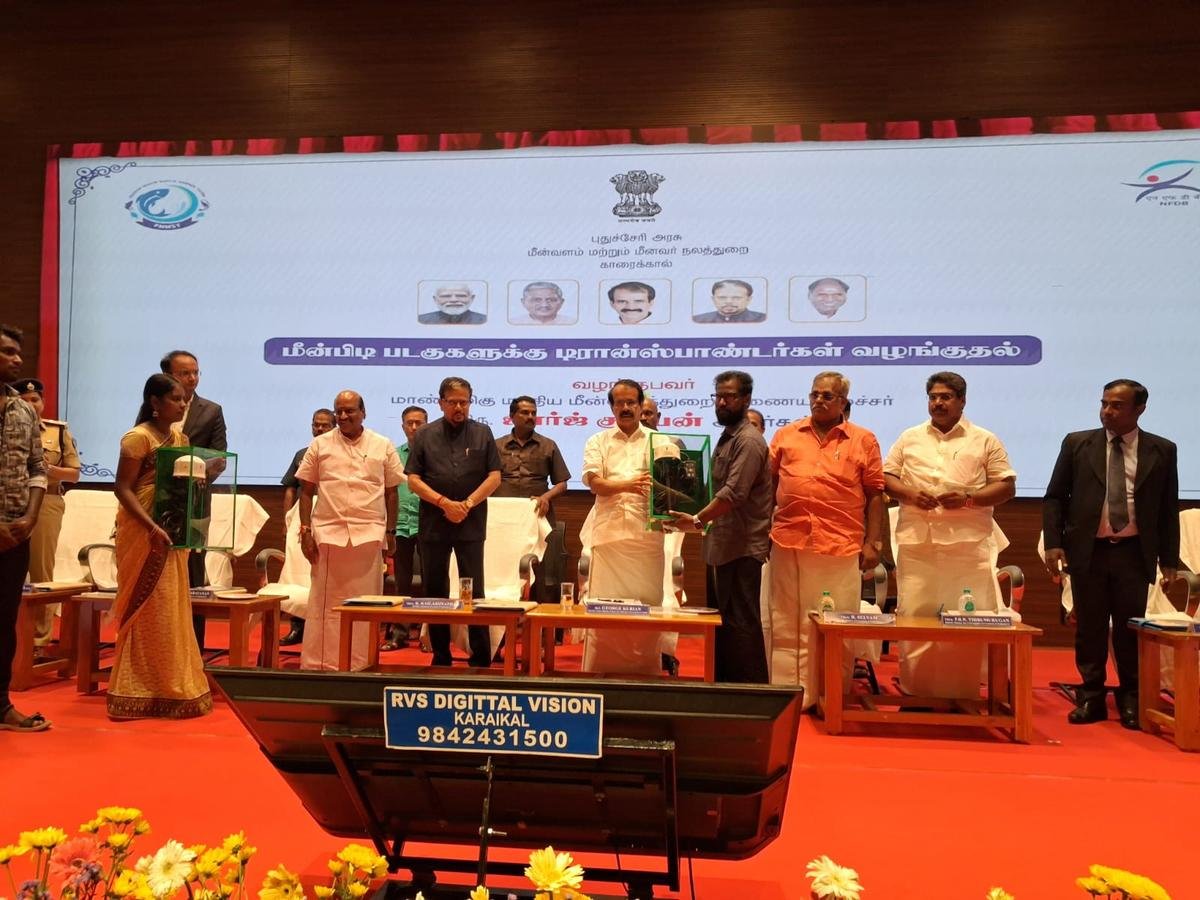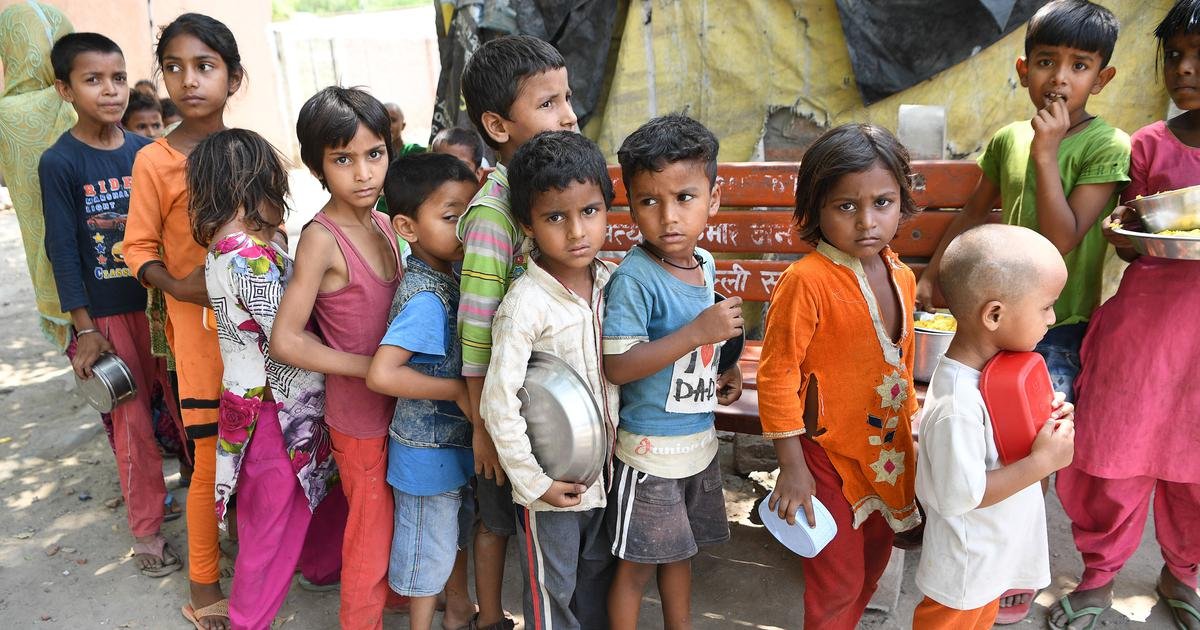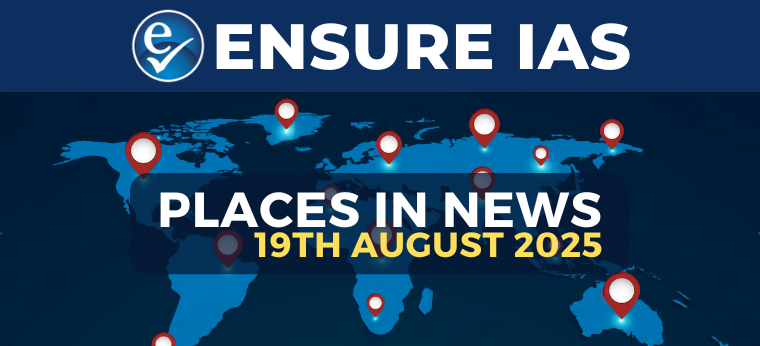Why in the News?
- The Union Government has approved the establishment of a first-of-its-kind, advanced fisheries processing cluster in Karaikal, a part of the Union Territory of Puducherry, under the Pradhan Mantri Matsya Sampada Yojana (PMMSY).
- The project, with a total estimated cost of ₹348.89 crore, including a Central grant of ₹298.34 crore, aims to modernize fisheries infrastructure, enhance processing capabilities, and significantly improve the socio-economic conditions of the fisher community in the region.
- The initiative represents one of the 34 fisheries production and processing clusters approved across India, reflecting the government’s broader strategy to promote organized fisheries development and value addition.
Key Highlights
- Project Approval, Cost, and Implementation
- The Union Government has sanctioned the project to develop an advanced fisheries cluster in Karaikal.
- A tender will soon be floated to initiate the construction and operationalization of the cluster.
- Integration with Partnering Fishing Harbours
- The Thengaithittu fishing harbour in Puducherry has been notified as a partnering harbour for the Karaikal cluster.
- By integrating two major harbours, the initiative aims to enhance the overall capacity of the fisheries sector in Puducherry and ensure complementary development of the region’s marine and inland fisheries economy.
- Cluster-Based Approach to Fisheries Development
- The initiative is designed to transform selected regions into integrated fisheries clusters, ensuring strong backward and forward linkages for production, processing, and marketing.
- The cluster approach will lead to the modernization of fisheries infrastructure, development of value-added facilities, and improved access to domestic and international markets.
- By enabling economies of scale, the initiative is expected to increase competitiveness and enhance productivity in the fisheries sector.
- Socio-Economic Benefits for the Fisher Community
- Fisherfolk are likely to benefit from higher income opportunities due to improved handling, processing, and marketing facilities.
- The cluster will develop integrated value chain infrastructure, including cold storage chains, ice plants, processing units, and transport logistics, reducing post-harvest losses and ensuring quality products reach the market.
- The initiative is expected to generate employment, promote skill development, and encourage entrepreneurship among coastal youth and women, thus improving livelihoods and social empowerment.
- Convergence with PM-MKSSY and Cooperative Support
- The Pradhan Mantri Matsya Kisan Samrudhi Sah Yojana (PM-MKSSY) will complement the cluster by supporting 15 Primary Fisheries Cooperative Societies (PFCS) in Puducherry.
- Each PFCS will receive financial assistance of ₹2 lakh, mentoring, and guidance for business planning and capacity-building from the Pondicherry State Fishermen Cooperative Federation Limited (PSFCFL).
- The National Fisheries Development Board (NFDB) will act as the nodal agency for overall coordination and implementation, ensuring convergence and synergy between both initiatives.
| Economies of Scale 1. Definition: Economies of scale occur when the average cost of production per unit decreases as the scale of production increases. 2. Cause: This happens due to spreading fixed costs over more units, specialization of labor, and better utilization of resources. 3. Types: They can be internal (within the firm) or external (within the industry or cluster). 4. Example: A car manufacturer producing 10,000 cars per year may have higher per-unit costs than producing 100,000 cars, because machinery, labor, and raw material costs are used more efficiently at a larger scale. Primary Fisheries Cooperative Societies (PFCS) 1. PFCS are member-based organizations of fishers and fish farmers formed at the village or local level to promote collective activities in fisheries, including production, marketing, credit, and input supply. 2. Purpose: a. To improve fishers’ income through better access to markets and inputs. b. To facilitate collective bargaining for prices and resources. c. To promote sustainable and organized development of the fisheries sector. 3. Structure: a. Governed by a committee elected by members. b. Members include local fishers, fish farmers, and other stakeholders directly involved in fisheries activities. 4. Example: Many Primary Fisheries Cooperative Societies in Kerala help small-scale fishers access ice, cold storage, and marketing facilities, ensuring better returns. |
Pradhan Mantri Matsya Sampada Yojana (PMMSY)
- Launch and Implementing Authority:
- The Pradhan Mantri Matsya Sampada Yojana (PMMSY) was launched in 2020 by the Department of Fisheries under the Ministry of Fisheries, Animal Husbandry, and Dairying.
- The scheme aims to promote ecologically sustainable, economically viable, and socially inclusive development of India’s fisheries sector.
- Objectives of PMMSY: The key objectives of the PMMSY include:
- Harnessing the potential of the fisheries sector in a sustainable, responsible, inclusive, and equitable manner.
- Enhancing fish production and productivity through expansion, intensification, diversification, and efficient utilization of land and water resources.
- Modernizing and strengthening the fisheries value chain, including post-harvest management and quality improvement.
- Doubling the income of fishers and fish farmers while generating meaningful employment opportunities.
- Increasing the contribution of the fisheries sector to Agriculture GVA and exports.
- Ensuring social, physical, and economic security for fishers and fish farmers.
- Establishing a robust fisheries management and regulatory framework.
- Scheme Structure: PMMSY functions as an umbrella scheme with two main components: Central Sector Scheme (CS) and Centrally Sponsored Scheme (CSS).
- The CSS component is further divided into beneficiary-oriented and non-beneficiary-oriented activities under the following broad categories:
- Enhancement of Production and Productivity
- Infrastructure and Post-Harvest Management
- Need for PMMSY
- Role of Fisheries and Aquaculture: Fisheries and aquaculture are crucial for food security, nutrition, employment, and income generation. Approximately 16 million people are directly employed in this sector, with many more involved indirectly along the value chain.
- Economic Contribution: In 2018-19, the sector contributed 24% of India’s national GVA and 7.28% of Agriculture GVA, making it an important driver of economic growth.
- Resource Potential: India has abundant marine fishing resources, estimated at 4.41 million tons, along its 8,118 km coastline. Efficient utilization of these resources is essential to boost fish production.
- Blue Revolution: The government initiated the Blue Revolution (2015–2020) to promote comprehensive development in fisheries.
- Exports and Earnings: India is a major seafood exporter, earning substantially from it. Brackish water aquaculture contributed 70–75% of total fishery exports in FY 2020.
- Economic Growth Opportunity: Developing the fisheries sector further can increase fish production, boost exports, generate employment, and contribute to overall economic growth.
- The CSS component is further divided into beneficiary-oriented and non-beneficiary-oriented activities under the following broad categories:
| Aquaculture 1. It is the controlled cultivation of aquatic organisms such as fish, crustaceans, mollusks, and aquatic plants in freshwater, brackish water, or marine environments for food, commercial, or recreational purposes. 2. Purpose: a. To increase fish production and productivity. b. To ensure sustainable use of aquatic resources. c. To support livelihoods and income generation for fishers and farmers. 3. Types: a. Freshwater aquaculture: ponds, tanks, and reservoirs. b. Brackish water aquaculture: coastal lagoons, estuaries, and shrimp farming. c. Marine aquaculture: open sea cages and coastal areas. 4. Example: India’s brackish water shrimp farming in Andhra Pradesh and West Bengal contributes significantly to seafood exports. |
Pradhan Mantri Matsya Kisan Samridhi Sah-Yojana (PMMKSSY)
- Scheme Type and Implementation: PMMKSSY is implemented as a Central Sector Sub-scheme under the Central Sector Component of the Pradhan Mantri Matsya Sampada Yojana (PMMSY).
- Funding and Outlay: The scheme has an estimated outlay of Rs. 6,000 crore, funded as follows:
- 50% (Rs. 3,000 crore) through public finance, including external financing from the World Bank and the Agence Française de Développement (AFD).
- 50% (Rs. 3,000 crore) is anticipated as beneficiary or private sector investment leverage.
- Implementation Period: PMMKSSY will be implemented for four years from FY 2023-24 to FY 2026-27 across all States and Union Territories.
- Intended Beneficiaries:
- Individuals directly engaged in fisheries: Fishers, fish (aquaculture) farmers, fish workers, fish vendors, and others involved in the fisheries value chain.
- Micro and small enterprises:
- Proprietary firms, partnership firms, and companies registered in India.
- Societies, Limited Liability Partnerships (LLPs), cooperatives, federations, and village-level organizations such as Self Help Groups (SHGs).
- Fish Farmers Producer Organizations (FFPOs) and startups engaged in fisheries and aquaculture value chains.
- FFPOs also include Farmers Producer Organizations (FPOs).
- Other beneficiaries: Any additional beneficiaries identified by the Department of Fisheries, Government of India.
- Aims and Objectives
- Formalization of the fisheries sector: Gradual formalization of the unorganized fisheries sector through self-registration of fishers, fish farmers, and supporting workers. Creation of work-based digital identities on the National Fisheries Sector Digital Platform to improve service delivery.
- Access to financing: Facilitate access to institutional financing for micro and small enterprises in the fisheries sector.
- Aquaculture insurance: Provide one-time incentives to beneficiaries for purchasing aquaculture insurance.
- Performance-based incentives:
- Grant performance incentives to microenterprises for improving fisheries sector value chain efficiency, including creation and maintenance of jobs.
- Support micro and small enterprises in adopting and expanding fish and fishery product safety and quality assurance systems, with performance grants linked to job creation and sustainability.
Implications
- Economic Growth and Market Expansion
- The establishment of the cluster will boost the overall fisheries economy of Puducherry by enabling modern processing and value addition.
- Fisher products will have better access to domestic and international markets, improving profitability and reducing dependency on middlemen.
- Infrastructure Development and Modernization
- The cluster will create a modern integrated infrastructure comprising processing units, cold storage facilities, ice plants, and transport logistics, reducing post-harvest losses and enhancing product quality.
- By modernizing infrastructure, the project will make fisheries operations more efficient and sustainable.
- Social and Community Empowerment
- Enhanced income opportunities will improve the living standards of fisher families, particularly among coastal youth and women.
- Skill development programs will strengthen entrepreneurship and capacity building, ensuring long-term socio-economic benefits for the community.
- Sustainable and Organized Fisheries Development
- The cluster-based model promotes organized fisheries and aquaculture, reducing fragmentation in production and processing.
- Cooperative-led management ensures community participation, equitable growth, and environmental sustainability through better resource management.
- Policy Synergy and Strategic Impact
- The convergence of PMMSY and PM-MKSSY ensures effective utilization of resources, mentorship support, and long-term sustainability.
- The initiative could serve as a replicable model for cooperative-led fisheries development in other coastal regions of India.
Challenges and Way Forward
| Challenges | Way Forward |
| Delays in project implementation due to tendering and coordination complexities. | Fast-track the tendering process and implement strict monitoring mechanisms by NFDB and UT administration. |
| Maintenance and operational sustainability of infrastructure may face funding gaps. | Encourage Public-Private Partnerships (PPPs) and cooperative-led management for long-term operational efficiency. |
| Fluctuations in market demand and prices may affect fisher income. | Develop robust market linkages, export promotion strategies, and insurance schemes to protect fisher livelihoods. |
| Lack of skills and knowledge among fisherfolk in modern processing techniques. | Conduct training programs, workshops, and skill development initiatives focused on value addition and marketing. |
| Environmental and sustainability concerns, such as overfishing and waste management. | Implement eco-friendly technologies, sustainable fishing practices, and effective waste disposal systems. |
Conclusion
The proposed advanced fisheries processing cluster at Karaikal represents a milestone in India’s fisheries modernization efforts. By integrating major harbours and aligning with PM-MKSSY, the project aims to improve infrastructure, increase fisher incomes, and provide access to wider markets. Additionally, the cooperative-led approach ensures community participation and sustainable development. If implemented effectively, the initiative has the potential to make Puducherry a model region for organized, sustainable, and inclusive fisheries development in India.
| Ensure IAS Mains Question Q. Discuss the significance of the newly approved advanced fisheries processing cluster in Karaikal under PMMSY. Highlight its socio-economic benefits, infrastructural developments, and potential challenges. (250 words) |
| Ensure IAS Prelims Question Q. Consider the following statements regarding the recently approved fisheries cluster in Karaikal: 1. The cluster is being developed under the Pradhan Mantri Matsya Sampada Yojana (PMMSY). 2. Thengaithittu harbour in Puducherry has been notified as a partnering harbour for this cluster. 3. The National Fisheries Development Board (NFDB) is the nodal agency responsible for the cluster’s implementation. 4. The cluster’s total project cost is ₹500 crore, entirely funded by the Central Government. Which of the statements given above is/are correct? a) 1 and 2 only b) 1, 2, and 3 only c) 2, 3, and 4 only d) All of the above Answer: b) 1, 2, and 3 only Explanation: Statement 1 is correct: The Karaikal advanced fisheries processing cluster has been sanctioned under PMMSY, a flagship scheme of the Union Government aimed at modernising fisheries infrastructure, increasing production, promoting value addition, and improving the socio-economic condition of fisherfolk across India. This ensures organized development and integrated fisheries clusters. Statement 2 is correct: The Union Government has designated Thengaithittu harbour as a partnering harbour to complement the Karaikal cluster. This integration of two major harbours aims to strengthen the fisheries ecosystem in Puducherry, improve logistics, and increase overall efficiency, ensuring better market access and higher income for local fisherfolk. Statement 3 is correct: The NFDB has been appointed as the nodal agency to coordinate and implement the Karaikal fisheries cluster. It ensures proper planning, convergence with other schemes such as PM-MKSSY, supervision of infrastructure development, and monitoring the benefits for the fisher community, ensuring effective execution and sustainability. Statement 4 is incorrect: The total project cost is ₹348.89 crore, not ₹500 crore, and the funding is partially through a Central grant of ₹298.34 crore, with the remainder coming from other sources. |




